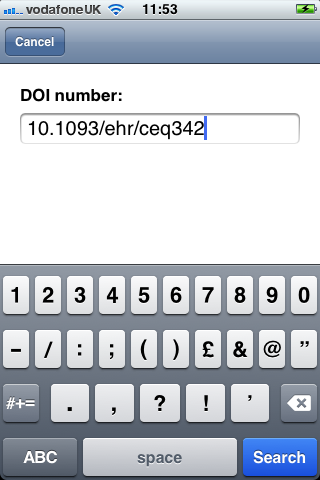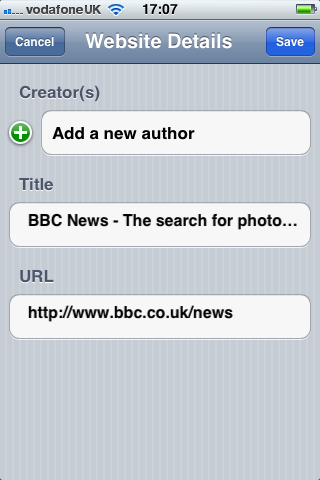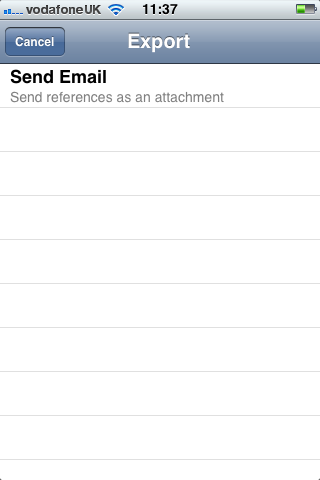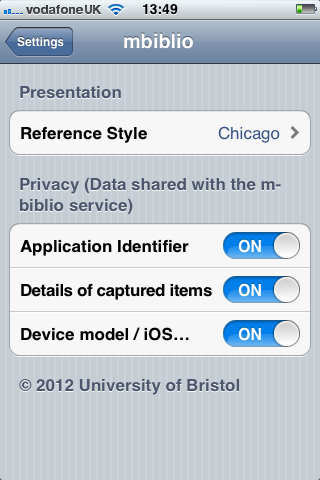The current version of the iOS application allows you to:
- Scan ISBN numbers for book details
- Scan University Library barcodes for book and thesis details
- Enter DOI numbers for papers and articles
- Extract the title of a website
- Manually add the details of books, papers and thesis
- Export the references via email to Rich Text Format (RTF) or HTML
- Support for the Chicago and Harvard reference styles
The application only supports those devices that have a camera that can auto-focus (iPhone 3GS, 4 and 4S and the iPad 3). We need a camera that can autofocus for barcode reading. It would be possible to have the application check the capabilities of the device and only have the ‘scan’ option appear if you have an appropriate device.
This rest of this post provides a tour of the user interface and the functionality of the application.
The Main Screen
The main screen of the application shows a scrollable list of captured references:

By default the references are displayed in the Harvard style, but it is possible to switch to the Chicago style:

You can edit the details of captured references or delete them completely:


If you have captured a large number of references you can search by keywords (author or title):

Adding a Reference
The ‘Add’ icon on the top right of the main screen shows a new screen that allows you to add new references:

For example, we can scan a University Library barcode or an ISBN barcode with the camera on the phone:

After a successful scan, the app will query the m-biblio service for bibliographic data:

The end user can then modify the data (if they wish) before saving:

You can also type in a barcode number with a custom keyboard:


For Digital Object Identifiers (DOIs) you can type in the reference:


It would be better, in a future version of the app, if the DOI could be scanned in using some Optical character recognition (OCR) technique. The DOI numbers can be long and have a mix of numbers and characters which are prone to error when submitting on the iOS keyboard. For example, the DOI for J.C. Holt’s article on ‘Anglo-Norman Feudalism’ is ‘10.1111/j.1468-0289.1963.tb01721.x’.
You can also extract information about a website:


At the moment, you can only extract the title of a website. In the future, it would be nice to extract data from meta tags if they are relevant, such as details of authorship.
Exporting the references
On the main screen the “Share” button allows you to export the references that you have captured. You can only export data via an email attachment (although there is code to support BibServer). You choose a format (Harvard or Chicago) and whether or not you want an RTF file or HTML:




Preferences
The preferences for the panel allows you to choose which reference style should be used for displaying references within the application. It also allows you to determine what information you are willing to share with the m-biblio service: (1) a unique identifier for the app; (2) the details of the captured items, i.e. the barcode or DOI number; (3) the type of device you are using (iPhone, iPad etc.) and which version of the operating system.

What’s missing
The is missing a number of things:
- The ability to manage references within collections. For example, you might have a collection for each assignment or task.
- Support for Endnote – it is vital that you can export your references to existing bibliographical material.
- More citation styles need to be supported and the ability to tweak the ones that are supported. For example, how many authors should be listed before et alias is used.
- We support books, but not chapters within books.
This looks great Mike – what is your intended release date? And – do you need any Beta testers?? 🙂
Cheers,
Judy
It’s looking good Mike! I look forward to trying this latest version sometime.
Judith – No immediate plans for a release. It needs more work and we need to look at the licensing issues relating to the data sources we are using. We are just beta testing within the University at the moment but I’ll be in touch if we need more testers :).
Ben – thanks! 🙂
Mike, it didn’t take me long to scan in barcodes from a shelf of books in my office – all recognised and I typed my thesis and a paper in too. A couple of things that would improve it for me (but this is from a staff perspective rather than student):
– have a start page rather than an empty screen with + and share icons … as you know, I wasn’t entirely sure what to do, so a simple screen that says: ‘Add …’ (that takes you to the add page), and ‘list’ that gives the current list of references and ‘search’ etc. would be helpful
– allow sorting of the references in the list by surname (first author/editor) and/or publication date and maybe some other options
– some fields default to upper initial character while others don’t; not sure whether this is deliberate but I didn’t notice at first, so had to backspace or go to that part of the text to edit
– I’d quite like to be able to add myself as an author/editor and then have the option for manually added entries to add myself (like IRIS)
– Ability to import a person’s publications from IRIS (or whatever replaces it) or a set of citations from the web in some way would be a useful addition for a future app (everything my supervisor’s written for example) – and maybe import from EndNote or similar if you’ve already started a list, so you’ve got them on the move and can add to them as you go?
– I know it’s not the aim of m.biblio really, but I can see value in capturing these data not just as a collection of references that can be used, but having additional fields – could be tick boxes, or free text, or combination, that indicate things like: cited in essay on X; read; see annotated copy in red folder, keywords etc. These might be covered by being able to add references to ‘projects’ that you mention though.
PS – on the point about ‘adding myself’ as author – this could equally apply to a student gathering multiple paper references by the same or frequently-occurring authors. typing them in again each time (if nothing to scan) could be a bit tedious, so having a ‘recently used’ or ‘add author to frequently used’ or something option might be useful particularly for journal articles.